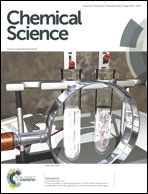Synthesis of various supramolecular hybrid nanostructures based on pillar[6]arene modified gold nanoparticles/nanorods and their application in pH- and NIR-triggered controlled release†
Abstract
We have developed a new strategy to prepare various hybrid nanostructures based on host–guest interactions. Organic/inorganic supramolecular hybrid micelles, onion-like disks and vesicles were obtained by the self-assembly of water-soluble pillar[6]arene WP6 stabilized gold nanoparticles with different amounts of a hydrophobic chain functionalized paraquat derivative 2 in water. Compared with the fabrication of hybrid nanostructures based on the self-assembly of amphiphile stabilized metal nanoparticles, this supramolecular method can be used to easily prepare various hybrid nanostructures by only changing the amount of 2, without the necessity to synthesize different amphiphilic stabilizers for different hybrid nanostructures. Furthermore, we prepared hybrid vesicles using WP6 stabilized gold nanorods and 2. These nanorod supramolecular hybrid vesicles were employed to encapsulate small molecules within their interiors under neutral conditions, and release them in response to a pH decrease or NIR irradiation.
![Graphical abstract: Synthesis of various supramolecular hybrid nanostructures based on pillar[6]arene modified gold nanoparticles/nanorods and their application in pH- and NIR-triggered controlled release](/en/Image/Get?imageInfo.ImageType=GA&imageInfo.ImageIdentifier.ManuscriptID=C4SC01647E&imageInfo.ImageIdentifier.Year=2014)

 Please wait while we load your content...
Please wait while we load your content...